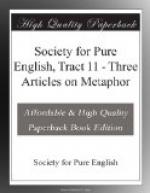Title: Tract XI: Three Articles on Metaphor
Author: Society for Pure English
Release Date: August 28, 2004 [EBook #13311]
Language: English
Character set encoding: ASCII
*** Start of this project gutenberg EBOOK three articles on metaphor ***
Produced by David Starner, Project Manager, Keith M. Eckrich, Post-Processor, and the Project Gutenberg Online Distributed Proofreaders Team
SOCIETY FOR PURE ENGLISH
TRACT No. XI
THREE ARTICLES ON METAPHOR
By E.B., H.W. Fowler & A. Clutton-Brock
MISCELLANEOUS NOTES & CORRESPONDENCE
At the Clarendon Press
1922
THREE ARTICLES ON METAPHOR
I. NOTES ON THE FUNCTION OF METAPHOR
The business of the writer is to arouse in the mind of his reader the fullest possible consciousness of the ideas or emotion that he is expressing.
To this end he suggests a comparison between it and something else which is similar to it in respect of those qualities to which he desires to draw attention. The reader’s mind at once gets to work unconsciously on this comparison, rejecting the unlike qualities and recognizing with an enhanced and satisfied consciousness the like ones. The functions of simile and metaphor are the same in this respect.
Both simile and metaphor are best when not too close to the idea they express, that is, when they have not many qualities in common with it which are not cogent to the aspect under consideration.
The test of a well-used metaphor is that it should completely fulfil this function: there should be no by-products of imagery which distract from the poet’s aim, and vitiate and weaken the desired consciousness.
A simile, in general, need not be so close as a metaphor, because the point of resemblance is indicated, whereas in a metaphor this is left to the reader to discover.
When a simile or metaphor is from the material to the immaterial, or vice versa, the analogy should be more complete than when it is between two things on the same plane: when they are on different planes there is less dullness (that is, less failure to produce consciousness), and the greater mental effort required of the reader warrants some assistance.
The degree of effort required in applying any given metaphor should be in relation to the degree of emotion proper to the passage in which it is used. Only those metaphors which require little or no mental exertion should be used in very emotional passages, or the emotional effect will be much weakened: a far-fetched, abstruse metaphor or simile implies that the writer is at leisure from his emotion, and suggests this attitude in the reader.—[E.B.]




